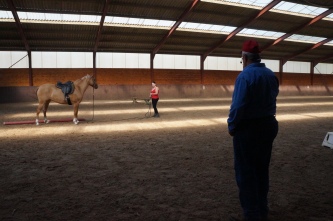Welcome at lesson 2 from the series ’10 lessons learned from a true Horseman’. In the last article you could have read about the use of psychology during your training and why this is so important. In this article we will discuss the importance of consistent behavior…from you!
Of course we’ve already heard this one hundred times and most of us have probably, at one moment or another, complained about the inconsistent behavior of another rider….because, let’s be honest; it’s a lot easier to see other people’s faults than our own, right?
Today we will talk about this subject, but we’ll not talk about the small specifics. We won’t discuss the question of ‘if I ask my horse to stand quietly, am I consistent whenever he takes that extra step?’. Today I would like to talk to you about the importance of using a systematic approach to training.
What does this mean and why is it so important?
An example from the past NH Experience with Berni Zambail, the Horseman we’ve been discussing:
We were dealing with a horse that was relaxed in his environment but that got distracted whenever he passed the open arena door and got a chance to look outside. And when he did it made him nervous again (more to read on this subject you’ll find in the article ‘Spooking! Should I or should I not allow him to look?’). Of course you can just block your horse from looking outside but in our last article we already discussed another option.
In this case the game, exercise or system we used to solve the problem; every time the horse passed the open door on the circle and got distracted, he would be asked to make a transition (up, down or change of direction).
This way he wasn’t feeling criticized for being distracted but we just gave him something else to keep his mind busy instead of the open door and his fears. This pattern was kept up until he finally started to focus more on his partner than on the arena door and this made him more relaxed.
This process took some time and it is common that when you don’t have a lot of experience with these kinds of games you start to doubt yourself when it takes a bit longer. These are a couple of questions that tend to come up in these moments:
- Am I consistent enough? Am I doing too much or too little?
- Am I using the right strategy or am I completely off track?
- Is what I’m asking my horse exciting enough or maybe too exciting?
- Has there been a good change in my horse that I have failed to notice?
It’s great that you’re asking yourself these questions but keep in mind that change usually takes some time to happen. Give yourself and your horse the chance to start thinking and change bit by bit. Don’t start thinking too soon that it is taking too long; especially when you’re not in a life or death situation (and I hope I can assume you don’t get into these kinds of situations a lot), than what is the harm in just keeping at it a little longer until the change happens? Don’t forget that horses are pattern animals; a lot of times the easiest way to teach them something is by simply repeating the exercise, in the right way, until they see the pattern.
So when you start a new pattern work at it systematically. Don’t stop before you get at least one of the following results:
- Your horse licks, chews, relaxes his jaw muscles
- Your horse shows a general release of tension
- Your horse starts to put effort into the exercise (responding lighter or quicker to your aids)
- Your horse starts to ask you questions or tries to connect with you (looks at you with eager ears)
And, like I tell my students when they get impatient sometimes…’it never takes longer than 2 days.’ I know 2 days seems like a long time for an exercise…but usually really you’ll never get even close to 2 days…more like 5 minutes that seem like an eternity. But have the discipline to stick to it and look for that change of attitude. I can guarantee you that if you will, next time you start the same game, you’ll get the result way sooner!
But what if you’ve really waited for the result, your horse has shown some signs of relaxation but the result you hoped for isn’t coming about. In that case it’s probably time to change your strategy. There is nothing wrong with that, as long as you’ve given your first strategy a chance to work before you switch!
So my challenge to you this week; whenever you’re training with your horse remind yourself what the goal of the exercise is and stick to it until you get a positive change. Because, remember; training animals is simple (easy is something totally different of course!) you just reward the behavior you like and it will start to show itself more often.
* Of course this article is not about behaviour that can damage your horse physically or emotionally. If you are dealing with serious behaviour and your horse get’s dangerously stressed, please consult a professional before continuing on your own.
Lees je het artikel liever in het Nederlands? Hieronder vind je het origineel—> Continue reading


